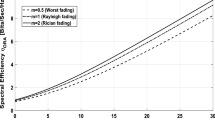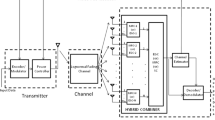Abstract
Where multiple-input receivers are concerned diversity combining is one of the most efficient techniques against fading effects. In this paper we propose a multipleinput adaptive combiner-equalizer. The novelty of the solution lies in the unified combining-equalization approach - the two classical operations being performed simultaneously and not sequentially. Our simulations show significant performance in terms of outage probability for both indoor and outdoor conditions, while complexity is lower than for a classical MRC implementation. The concept of unifying certain operations along the transmission chain is feasible today more than ever as it can be easily implemented on SDR (Software Defined Radio) platforms.
Access this chapter
Tax calculation will be finalised at checkout
Purchases are for personal use only
Preview
Unable to display preview. Download preview PDF.
Similar content being viewed by others
References
Angeliki Alexion, Martin Haardt, “Smart Antenna Technologies for Andreea Goldsmith, “Wireless Communications”, Stanford University, Cambridge, Univ. Press, 2005.
Ramasamy Venkatasubramanian, “Beamforming for MC-CDMA”, Master Thesis at Virginia Polytechnic Institute and State University
Cui, J., Falconer, D. D., and Sheikh, A. U. 1997. Performance evaluation of optimum combining and maximal ratio combining in the presence of co-channel interference and channel correlation for wireless communication systems. Mob. Netw. Appl. 2, 4 (Dec. 1997), 315–324.
Chong-Yung Chi, Chih-Chun Feng, Chii-Horng Chen and Ching-Yung Chen, “Blind Equalization and System Identification Batch Processing Algorithms, Performance and Applications”, Springer-Verlag London Limited 2006, ISBN-10: 1846280222.
Mohamed-Slim Alouini, “Adaptive Modulation and Combining for Bandwidth and Power Efficient Communication over Fading Channels”, Third BEATS/CUBAN/WIP Workshop, Sidi Bou Said, Tunisia, May 23, 2005.
Hong-Chuan Yang, Nesrine Belhaj, and Mohamed-Slim Alouini, “Performance Analysis of Joint Adaptive Modulation and Diversity Combining Over Fading Channels”, IEEE Transactions On Communications, Vol. 55, No. 3, March.2004
Ahmed Iyanda Sulyman, Maan Kousa, “Bit Error Rate Performance Analysis of a Threshold-Based Generalized Selection Combining Scheme in Nakagami Fading Channels”, EURASIP Journal onWireless Communications and Networking 2005:2, 242–248, 2005 Hindawi Publishing Corporation.
Berber, S.M.; Kecman, V., “Convolutional decoders based on artificial neural networks,” Neural Networks, 2004. Proceedings. 2004 IEEE International Joint Conference on , vol.2, no., pp. 1551–1556 vol.2, 25–29 July 2004.
Ligia Chira, Tudor Palade, “The Adaptive Potential of Space Diversity Techniques”, The Mediterranean Journal of Electronics and Communications, Vol. 3, No. 3, 2007, pp.100–109, 2007 SoftMotor Ltd. ISSN: 1744–2400
IST-4–02776 WINNER II report, WINNER II channel models, 2007
Philip Balaban, Jack Salz, “Dual Diversity Digital Combining and Equalization in Cellular Mobile Radio”, IEEE Transactions On Vehicular Technology, vol. 40, no. 2, May 1991
Philip Balaban, Jack Salz, “Optimum Diversity Combining and Equalization in Digital Data Transmission with Applications to Cellular Mobile Radio-Part I: Theoretical Considerations and Part II: Numerical Results”, IEEE Transactions On Communications, vol. 40, no. 5, may 1992
Combiner-Equalizer Alcatel Patent, 1997
Author information
Authors and Affiliations
Corresponding author
Editor information
Editors and Affiliations
Rights and permissions
Copyright information
© 2010 Springer Science+Business Media B.V.
About this paper
Cite this paper
Cremene, L.C., Crisan, N., Cremene, M. (2010). An Adaptive Combiner-Equalizer for Multiple-Input Receivers. In: Sobh, T., Elleithy, K., Mahmood, A. (eds) Novel Algorithms and Techniques in Telecommunications and Networking. Springer, Dordrecht. https://doi.org/10.1007/978-90-481-3662-9_66
Download citation
DOI: https://doi.org/10.1007/978-90-481-3662-9_66
Published:
Publisher Name: Springer, Dordrecht
Print ISBN: 978-90-481-3661-2
Online ISBN: 978-90-481-3662-9
eBook Packages: EngineeringEngineering (R0)




